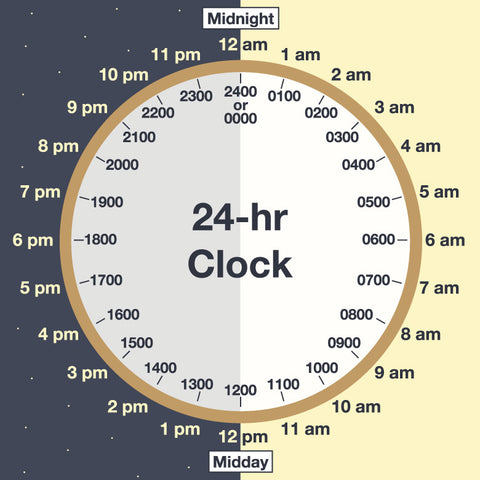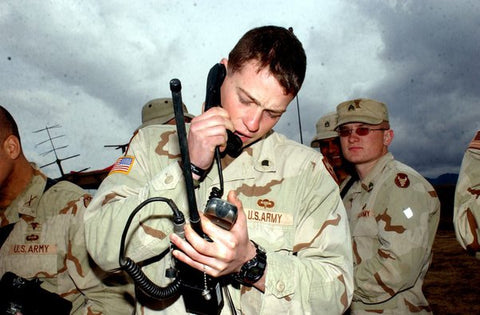
Understanding and being able to read military time is a valuable skill that often goes overlooked. Yet for anyone who is interested in fields like healthcare, aviation, emergency services, and of course, the military, it can be a crucial element of day-to-day life. Unlike the standard 12-hour clock, military time—also known as the 24-hour clock system—uses an unambiguous format that is regarded for its clear and exact time readings.
While the 12-hour clock with AM and PM notations is the standard in most areas, military time is a consistent feature in work environments where precision is paramount. If you're looking to bolster your time-telling skills or if you are simply curious about the ins and outs of military time, this guide breaks it down into three easy steps in how to learn military time.
Step 1: Deciphering the Basics
The first step in how to learn military time is to grasp the fundamentals. Unlike the 12-hour clock, military time continues the count into the afternoon and evening without resetting. The day is divided into 24 hours, starting at midnight (2400 hours).
The primary difference lies in how hours are represented and spoken. Military time does not employ the AM and PM distinctions. Instead, it utilizes a four-digit number to signify the time. For instance, straightforward times such as 5 AM or 5 PM become 0500 hours and 1700 hours, respectively, when converted to military time.
A helpful basic rule in how to learn military time is to remember that any hour from 0000 to 0959 retains the "hours past midnight" format. However, from 1000 hours onward, the hours notation includes the thousands place, and the "hundreds" do not exceed 24, signifying the end of the day. For example, 3:00 in the afternoon under the 12-hour clock is written and spoken as 1500 hours in military time.
To refine these basics in how to learn military time, consider practicing by converting standard times to military time and vice versa. Visualization can be an effective method in this stage. Use a clock face or create a timeline to chart the conversion process for various times of the day.

Step 2: Adopting a Conversion Strategy
How to learn military time relies on the development of a reliable conversion strategy to transition smoothly between military time and the standard 12-hour clock. The key to a successful strategy is understanding the principles behind military time and finding mnemonic devices that work for you.
A day ends, as we all know, at midnight or 12 AM. That is known as 2400 hours in military time because it is the 24th hour of the 24-hour day. However, a new day begins right at one second past midnight, but for the sake of illustration since we generally don’t track seconds when we tell time, the clock on a new day starts running at 12:01 AM.
Using this example, 12:01 AM would become 0001 hours in the 24-hour military clock because the 24-hour clock begins running at that time. With each hour we simply add a hundred for each whole hour. For example, the time 12:30 AM would be 0030 hours. The time 1:00 AM would become 0100 hours.
Minutes don’t really change. For example, 1:45 AM would become 0145 hours. In essence, you are simply adding an “O” before the numbers and removing the colon mark. As you can see, there are several ways on how to learn military time.
Put simply, after midnight for the first hour of the new day, times are used using four digits and the first two spaces in the time will be the letter “O” followed by the number zero in the second place. Once the first hour of the day is complete, the second digit becomes a one and the minutes are recorded using the third and fourth spots in the four-character line. So, 1:55 AM is O155. The number 55 represents the minutes.
At the core of the military time system is the need for precision and clarity. Knowing that "O," not "zero," designates hours can prevent misinterpretations over the radio or in handwritten notes. You should also familiarize yourself with the concept of "Zulu time," the standard time in the military and aviation, denoted by the letter "Z" and serving as a universal reference.
Mnemonics can be an invaluable tool for students to use in how to learn military time. Simple phrases or acronym-based systems can turn the initially daunting task of converting to military time into a more easily navigable process. For example, creating an acronym such as "PEMDAS" (Parentheses, Exponents, Multiplication and Division, Addition and Subtraction) can help remember the order of operations when dealing with numbers in calculations.
You could use similar devices for military time. Some popular ones include:
"Ate" for Eight: The word "ate" sounds like the numeral "8," serving as a memory aid for the 12-hour to 24-hour conversion.
"Eleven at Eleven" or "Twelve at Noon and Midnight": Mental images or associations can be powerful. If 11 o'clock is a challenge, thinking "eleven at eleven" can reinforce the 1100 hours conversion.
Step 3: Application and Reinforcement
With a strong foundation and conversion strategy in place, the final step in how to learn military time is practical application and ongoing reinforcement. Here are strategies for real-world application and continuous practice.
Start integrating the use of military time in your daily life. You can also create flashcards with standard and military times, quizzing yourself or friends. Set your devices, such as smartphones or digital watches, to display military time regularly. These are a few things you can do if you find yourself asking how to learn military time.

You can also attend events or watch news briefings where organizers or presenters use military time to announce schedules. If you have a relative or friend in the military or aviation fields, engage with them using military time in casual conversation.
Once you're comfortable with basic conversions, consider exploring more advanced techniques and scenarios. Learn about daylight savings time adjustments and how it applies to military time. Practice reading event logs or timetables and challenge yourself with time "math" problems where you add or subtract hours and minutes in military time.
Mastering military time is an enriching endeavor that broadens your horizons and could open new opportunities in various professional and academic avenues. By understanding the principles, adopting conversion strategies, and consistently applying and reinforcing your skills, you can confidently add military time interpretation to your list of proficiencies. Remember, practice makes perfect, and in time, your comfort with military time will become second nature.
1 comment
It would be helpful if you gave examples of how to speak military along with the written examples.